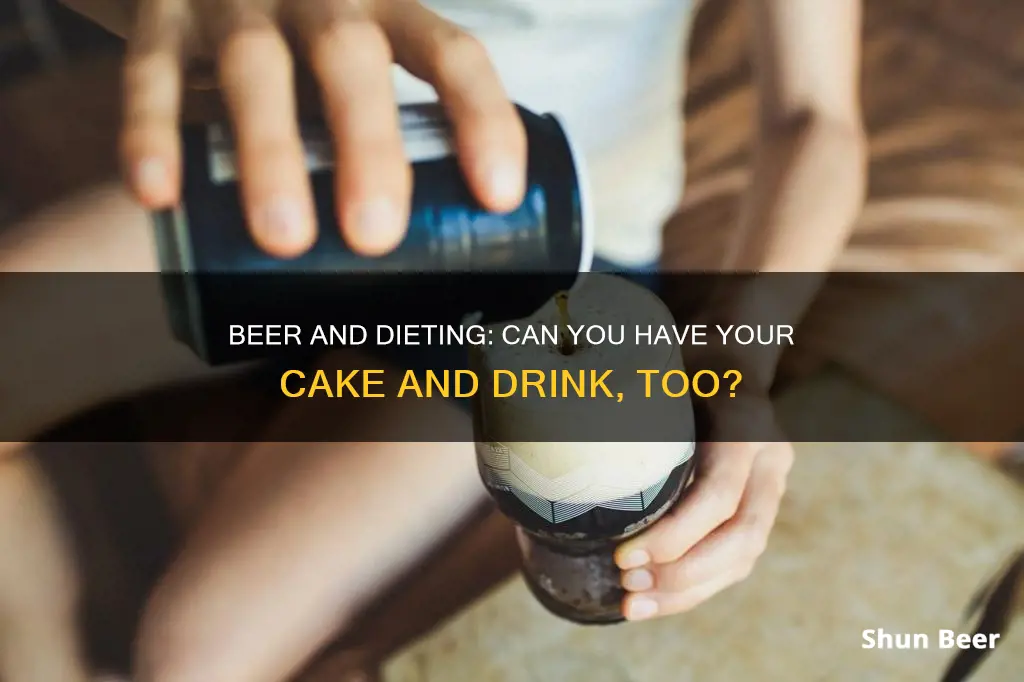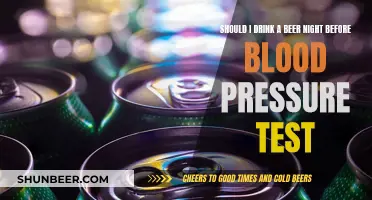
Beer and weight loss are not mutually exclusive, but it's a fine line to tread. Beer is often associated with weight gain because it is high in calories and does not fill you up. It can also negatively impact your sleep, which is linked to weight gain and muscle loss. However, you can still enjoy a beer and lose weight as long as you're mindful of your consumption and make adjustments to your diet and exercise routine.
| Characteristics | Values |
|---|---|
| Calories | Beer is high in calories, ranging from 100 to 350 calories for a 12-ounce (355 mL) glass, depending on the type and brand. |
| Nutrients | Beer is considered an "empty calorie" drink as it provides almost no nutrients. |
| Metabolism | Alcohol is prioritised by the body for processing over carbohydrates and fats, which can create a metabolic environment that inhibits fat burning. |
| Sleep | Alcohol can negatively impact sleep quality, which is linked to weight gain and muscle loss. |
| Self-control | Drinking can reduce inhibitions and increase the likelihood of overeating or making poor food choices. |
| Strategies | To drink beer and still lose weight, limit the number of beers per week, adjust eating habits, choose lower-calorie or lower-ABV options, and increase exercise. |
What You'll Learn

Beer is an empty calorie as it provides almost no nutrients
Beer is an alcoholic beverage, and alcohol is known to contain empty calories. Empty calories are those found in foods and drinks that are calorie-dense but provide little to no micronutrients, fibre, or protein. In other words, they provide energy but have low nutrient density. Beer, for example, contains calories but has minimal nutritional value beyond that.
The process of making alcohol involves the fermentation of starches and sugars, which are themselves sources of empty calories. The refining processes used to make modern beers have stripped them of almost all nutritional value, leaving only trace amounts of vitamins and minerals that can be obtained from other sources. As a result, beer contributes a significant number of calories to one's diet while providing almost no essential nutrients.
The high caloric content of beer can be problematic for those trying to manage their weight. A regular 12-ounce (355 mL) glass of beer contains about 150 calories, and a higher-alcohol or craft beer can have up to 350 calories in the same serving size. This is comparable to the caloric content of a full-sized Mars Bar, according to the NHS. Additionally, the body prioritises processing and eliminating alcohol, which means that while it is doing so, it is not burning fat or absorbing nutrients from other sources.
The lack of essential nutrients and the high caloric content of beer can lead to weight gain and malnutrition if consumed in excess. However, this does not mean that beer cannot be included in a balanced diet. Moderation is key, and there are ways to reduce the impact of beer on one's weight. For example, opting for light or low-alcohol beers, reducing portion sizes, and drinking less frequently can help to manage the number of empty calories consumed.
Beer and Colonoscopy: Drinking Timeline for the Procedure
You may want to see also

Beer is a liquid, meaning calories can be consumed quickly
Beer is a liquid, and liquids can be consumed quickly. This means that it is easy to drink a lot of calories without even realising it.
Beer is an "empty calorie" drink, providing almost no nutrients. This means that, unlike solid foods, beer will not fill you up. You could easily drink five beers (around 750 calories) and still have room for a full meal. This is why drinking beer can make losing weight so difficult.
The calories in beer come mainly from alcohol, but also from unfermented carbs and a small amount of protein. The higher the ABV, the higher the calories. A regular beer is around 150 calories for a 12-ounce (355 ml) glass, while a light beer is about 100 calories for the same amount. Craft beers can contain even more calories, ranging from 170 to 350 calories for a 12-ounce (355 ml) glass.
If you are trying to lose weight, it is important to be mindful of how many calories you are consuming. You can still drink beer, but you may need to consume it more mindfully. You should watch how many beers you are drinking and how it affects your eating habits. It may be helpful to set a limit for yourself before you start drinking and stick to it. You could also try switching to light beer or low-percentage ABV beer, or simply reducing your portion size by using a smaller glass.
Beer Collectables: A Guide to Their Functionality and Value
You may want to see also

Alcohol is metabolised differently to other macronutrients
Alcohol is metabolised differently from other macronutrients. When alcohol is swallowed, it is not digested like food. Instead, it is first absorbed directly by the tongue and mucosal lining of the mouth. In the stomach, alcohol is then absorbed directly into the bloodstream through the tissue lining of the stomach and small intestine. The rate of absorption is influenced by various factors, such as the presence of food in the stomach, the type of alcoholic beverage, and genetic factors.
Once alcohol is in the bloodstream, it is distributed throughout the body and can affect the brain and other organs within a short amount of time. Alcohol can enter all tissues of the body except bone and fat. The effects of alcohol vary depending on individual factors such as sex, body composition, the amount consumed, the presence of food, and the liver's ability to produce alcohol dehydrogenase enzymes.
The liver is primarily responsible for metabolising alcohol. Liver cells produce the enzyme alcohol dehydrogenase, which breaks down alcohol into ketones. This process occurs at a rate of about 0.015 g/100mL/hour, reducing the blood alcohol concentration (BAC) by 0.015 per hour. However, the effective metabolism of alcohol can be limited by medications and liver damage. When the rate of consumption exceeds the rate of detoxification, the BAC will continue to rise.
In addition to the liver, alcohol is also metabolised in extrahepatic tissues that do not contain alcohol dehydrogenase, such as the brain, by the enzymes cytochrome P450 and catalase. These enzymes contribute to the oxidative metabolism of alcohol, which involves adding oxygen or removing hydrogen. The products of alcohol metabolism, such as acetaldehyde and acetate, can have detrimental effects on the body and contribute to tissue damage and various diseases.
Overall, the unique metabolic pathways of alcohol, including its absorption, distribution, and elimination, differentiate it from other macronutrients and contribute to its complex effects on the body.
Root Beer Guzzling: How Much A&W is Too Much?
You may want to see also

Alcohol can negatively affect sleep
Drinking alcohol, including beer, can negatively affect your sleep. This is because alcohol disrupts your body's production of GABA, a neurotransmitter that helps you stay asleep. When your brain uses more GABA before you go to sleep from drinking alcohol, you have less while you're sleeping, causing a disruption in your sleep.
Alcohol can also cause you to get up several times during the night to go to the bathroom, which can also negatively impact your sleep. Lack of quality sleep is directly linked to both weight gain and muscle loss. One weight loss study found that people who slept for 5.5 hours lost 50% of their weight from muscle, compared to those who slept for 8.5 hours. Another study found that sleep-deprived people experienced a 45% increase in appetite for high-carbohydrate, calorie-dense foods.
Sleep is also important for your activity levels and the quality of your workouts. If you are well-rested, you are more likely to have a better workout. Therefore, drinking alcohol, including beer, can negatively impact your weight loss goals by disrupting your sleep.
To mitigate the negative impact of alcohol on your sleep, it is recommended to limit your alcohol consumption to no more than one drink per day for women and no more than two drinks per day for men. Additionally, choosing lower-calorie and lower-ABV drinks can help reduce the impact of alcohol on your sleep.
Beer and Ice Cream: A Match Made in Heaven?
You may want to see also

Beer may inhibit self-control
If you drink 5 beers (~750 calories), you will still have plenty of room in your stomach to have a full meal right after. Drinking alcohol can stop the process of fat burning completely. The foundation of losing weight is to eat fewer calories than you burn while staying full. That's why eating whole foods that fill you up but provide fewer calories is an effective eating strategy to get lean.
Beer is an "empty calorie" because it provides almost no nutrients. Beer is in liquid form, which means you can drink calories really fast. Beer contains alcohol, which is metabolized by the body differently from other macronutrients like protein, carbs, and fat.
The best strategy is to limit the number of beers you have per week. The fewer beers you drink, the fewer empty calories you are ingesting. Maybe it's one beer a day, or better yet, 2 beers on Friday or Saturday. Now, if you want the best results, go dry. Stop drinking beer completely. If you love beer and that's not an option for you, maybe it's the best option.
Drinking Beer in Public: Las Vegas Laws and Where to Enjoy
You may want to see also
Frequently asked questions
Yes, but it is harder to create a caloric deficit if you drink every day. If you are trying to lose weight, you can reduce calories and still enjoy a beer from time to time by drinking light or low % ABV beer, reducing your portion size, and drinking less frequently.
Beer drinking can affect your diet in a few ways. Firstly, beer is an "empty calorie" as it provides almost no nutrients, but still contains calories. Secondly, beer is a liquid, meaning you can drink calories very quickly. Thirdly, drinking alcohol can stop the process of fat burning as your body prioritises processing alcohol over burning fat. Finally, drinking alcohol can reduce your inhibitions, causing you to eat more than you usually would.
To lose weight while drinking beer, you can limit the number of beers you have per week, drink light beer, and adjust your eating habits by eating less food and focusing on lean protein sources and vegetables. You can also increase your exercise, change your diet, and monitor your alcohol intake.







